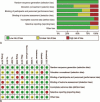The Adverse Events of Oxycodone in Cancer-Related Pain: A Systematic Review and Meta-Analysis of Randomized Controlled Trials
- PMID: 27082588
- PMCID: PMC4839832
- DOI: 10.1097/MD.0000000000003341
The Adverse Events of Oxycodone in Cancer-Related Pain: A Systematic Review and Meta-Analysis of Randomized Controlled Trials
Abstract
The adverse events (AEs) of oxycodone in cancer-related pain were controversial, so we conducted a meta-analysis to determine it. PubMed, Embase, CBM, CNKI, WanFang database, The Cochrane library, Web of Science, and the reference of included studies were searched to recognize pertinent studies. Relative risk (RR) with 95% confidence intervals (CIs) for all AEs were all extracted. The fixed-effects model was used to calculate pooled RRs and 95% CIs. Power calculation was performed using macro embedded in SAS software after all syntheses were completed. We identified 11 eligible trials involving 1211 patients: 604 patients included in oxycodone group and 607 patients involved in control group. Our quantitative analysis included 8 AEs, and the pooled analyses indicated that oxycodone compared with other opioids in cancer-related pain were not significantly decreased RRs of all AEs (dizziness RR = 0.94, 95% CI: 0.69-1.30, Z = 0.35, P = 0.72; nausea RR = 0.88, 95% CI: 0.72-1.07, Z = 1.26, P = 0.21; vomiting RR = 0.89, 95% CI: 0.70-1.15, Z = 0.9, P = 0.37; sleepiness RR = 0.86, 95% CI: 0.38-1.36, Z = 0.36, P = 0.72; constipation RR = 0.98, 95% CI: 0.81-1.19, Z = 0.21, P = 0.83; anorexia RR = 0.97, 95% CI = 0.58-1.62, Z = 0.11, P = 0.91; pruritus RR = 0.76, 95% CI: 0.44-1.30, Z = 1.01, P = 0.31; dysuria RR = 0.33, 95% CI: 0.07-1.62, Z = 1.36, P = 0.1)]. The subgroup analysis shown that Ox controlled-release (CR) had less sleepiness compared with MS-contin (Mc) CR (RR = 0.47, 95% CI: 0.25-0.90, P = 0.02). The power analysis suggests that all AEs have low statistical power. The present meta-analysis detected that no statistically significant difference were found among oxycodone and other opioids in all AEs, but Ox CR may had less sleepiness compared with Mc CR when subgroup analysis were conducted.
Conflict of interest statement
The authors have no conflicts of interest to disclose.
Figures










References
-
- King SJ, Reid C, Forbes K, et al. A systematic review of oxycodone in the management of cancer pain. Palliat Med 2011; 25:454–470. - PubMed
-
- Vallejo R, Barkin RL, Wang VC. Pharmacology of opioids in the treatment of chronic pain syndromes. Pain Physician 2011; 14:E343–E360. - PubMed
-
- Riley J, Branford R, Droney J, et al. Morphine or oxycodone for cancer-related pain? A randomized, open-label, controlled trial. J Pain Symptom Manag 2015; 49:161–172. - PubMed
-
- Zhang W-Z, Yu W-J, Zhao X-L, et al. Pharmacoeconomics evaluation of morphine, MS contin and oxycodone in the treatment of cancer pain. Asian Pac J Cancer P 2014; 15:8797–8800. - PubMed
-
- Yu S, Shen W, Yu L, et al. Safety and efficacy of once-daily hydromorphone extended-release versus twice-daily oxycodone hydrochloride controlled-release in Chinese patients with cancer pain: a phase 3, randomized, double-blind, multicenter study. J Pain 2014; 15:835–844. - PubMed
Publication types
MeSH terms
Substances
LinkOut - more resources
Full Text Sources
Other Literature Sources
Medical
Molecular Biology Databases

